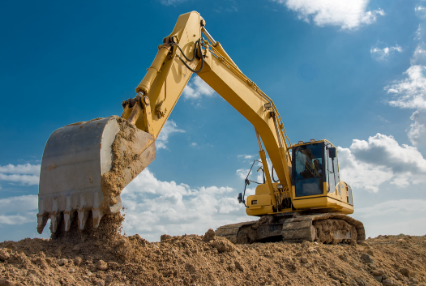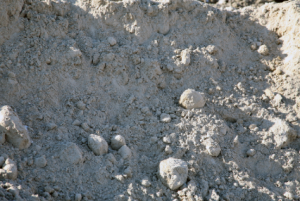28 Feb 2020
Materials Management on Construction Sites
Overview

FT recently carried out a review of materials management options for a civil infrastructure project. Effective materials management can enhance the sustainability and cost efficiency of construction projects. The objective of materials management for this project are to prevent waste generated on and off-site, to re-use excavated materials including construction and demolition materials, and options to import fill material. Materials include by-products, products, intertidal mud, waste and materials for re-use.
The waste management options considered the use of waste from other sites as a potential fill material. It is a requirement for waste disposal and recovery activities to hold an authorisation, and therefore this option is best explored at pre-planning stages of a project and included in the statutory consents’ procedure.
 The options report recommends planning for re-use of construction and demolition materials prior to construction activities. The definition of waste is important in this context; waste is defined under the Waste Directive as any substance or object which the holder discards or intends or is required to discard. Therefore, if re-use of specific materials is planned prior to demolition, the material does not become a waste and is not subject to waste management legislation. In planning for re-use the proposed material must be fit for purpose and will not pose a potential risk to the environment.
The options report recommends planning for re-use of construction and demolition materials prior to construction activities. The definition of waste is important in this context; waste is defined under the Waste Directive as any substance or object which the holder discards or intends or is required to discard. Therefore, if re-use of specific materials is planned prior to demolition, the material does not become a waste and is not subject to waste management legislation. In planning for re-use the proposed material must be fit for purpose and will not pose a potential risk to the environment.
The key proposal to enhance the sustainability and cost efficiency of this project was the import of required fill material as by-products under Article 27 of the European Communities (Waste Directive) Regulations 2011. Following a public consultation in 2018, the EPA published Guidance on Soil and Stone By-Products Version 3, (2019) in the context of Article 27 of the European Communities (Waste Directive) Regulations, 2011. The purpose of the guidance is to encourage the prevention of waste including the lawful and beneficial use of excess uncontaminated soil and stone. If the material of concern satisfies all four criteria in the guidance the manufacturer can proceed to notify the EPA that the material for re-use is regarded as a by-product and it can be handled accordingly. If the four criteria are not met, the material is a waste and is subject to waste management regulation. The guidance provides criteria that must be met in order to consider excess uncontaminated soil and stone as a by-product. The EPA will have regard to this guidance when determining, on a case-by-case basis, if a soil and stone material meets the criteria to be considered a by-product.
FT provided advice on how to prove compliance with all four criteria:
- further use of the substance or object is certain;
- the substance or object can be used directly without any further processing other than normal industrial practice;
- the substance or object is produced as an integral part of a production process; and
- further use is lawful in that the substance or object fulfils all relevant product, environmental and health protection requirements for the specific use and will not lead to overall adverse environmental or human health impacts.
Under Article 27, S.I. No.126 of 2011, paragraph 2(a):
‘Where an economic operator makes a decision in accordance with paragraph (1) that a substance or object is to be regarded as a by-product, he or she shall notify the Agency of the decision and the grounds for the decision.’
In response, the EPA has 10 weeks to either agree with the determination or initiate a consultation process with the economic producer. There is no timeframe for that process. The EPA however can disagree with the Producers determination, in which case the material is a waste. The EPA will endeavour to make a determination in all cases.
FT can assist with this process, ensuring that due process has been followed under Article 27 and that all information supplied to the EPA satisfies the four criteria to enable to the EPA to agree with the determination.
Where waste materials are located or generated on sites, it is necessary to handle in accordance with waste management legislation, i.e. transported off site by a carrier with a valid waste collection permit and transferred to an authorised facility (a waste permitted facility, a waste/IED licensed facility). In some cases, testing of the material may be required prior to transfer off-site. In this case, FT can recommend appropriate testing. It should be noted that waste material can only be classified as hazardous or non-hazardous and is required where there is a mirror entry in the List of Waste. To classify waste, a range of parameters should be tested based on the type of waste material. This analysis is carried out on the solids content.

Alternatively, soil testing can be carried out to determine potential contamination if any. Again, WAC testing is only applicable to waste material destined for landfill, it is not suitable for testing soils for recovery or re-use potential as a landfill has a basal liner and therefore affords a degree of environmental protection that recovery applications do not have.
In conclusion, following a review of options, the recommendation of the report is the preparation of a Materials Management Plan (MMP). This will detail how all construction phase materials (material resources and waste) will be managed in a sustainable and cost-efficient manner. The MMP should be underpinned by risk assessment. The MMP will provide clear objectives for the management of materials, therefore stating from the outset the criteria for re-use of materials and management of by-products. Traditionally a Waste Management Plan is generated for construction projects, an MMP is a more evolved management plan encompassing more materials and leading to increased cost efficiency and sustainability. It was recommended that by-products are sourced to meet the fill requirements of the project.
Click here for FT’s waste and resource management experience.

